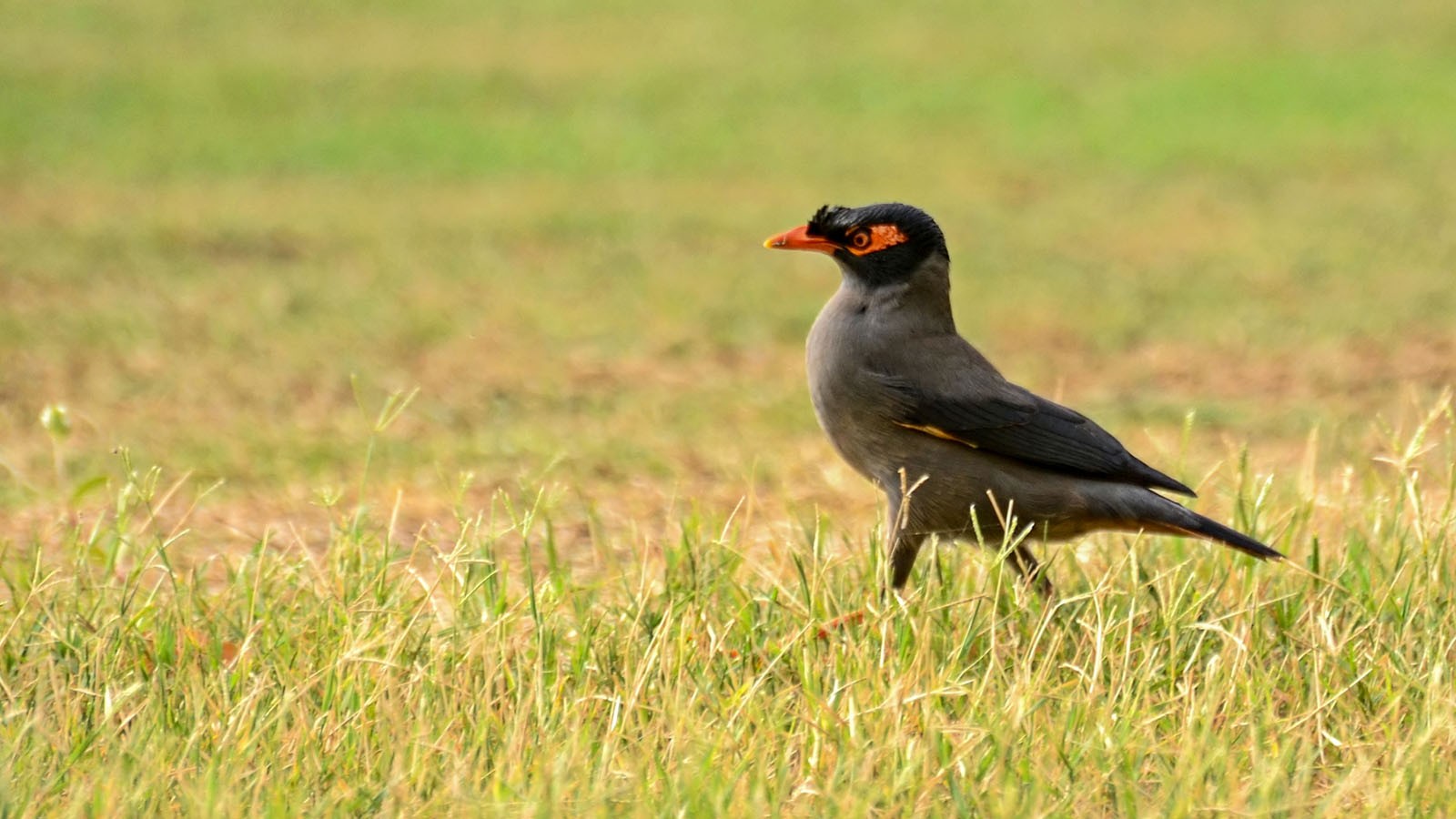Bank Myna
A species of Typical mynas Scientific name : Acridotheres ginginianus Genus : Typical mynas
Bank Myna, A species of Typical mynas
Botanical name: Acridotheres ginginianus
Genus: Typical mynas
Content
Description General Info
 Photo By Manish Kumar , used under CC-BY-SA-4.0 /Cropped and compressed from original
Photo By Manish Kumar , used under CC-BY-SA-4.0 /Cropped and compressed from original Description
The head is black on the crown and sides and the upper plumage is slaty grey while the underside is lighter grey with pale pink plumage towards the centre of the abdomen. The wing is black but has a wing patch at the base of the primaries and the tips of the outer tail feathers are pale pinkish buff. The naked skin behind the eye is brick red, the legs are yellow while the iris is deep red. The sexes are indistinguishable in the field. Young birds have a browner head and neck. The species is evolutionarily closest to the common myna. 
Size
22 cm
Nest Placement
Cavity
Feeding Habits
Bank Myna is omnivorous, feasting on a diverse diet including insects, tadpoles, snails, spiders, fruits like figs, and human food waste. They forage on the ground, often near cattle to eat ticks, and may feed on nectar. Nestlings are primarily fed insects. Bank Myna forms large communal roosts.
Habitat
Bank Myna typically inhabits man-modified landscapes within the Indian subcontinent. Preferring agricultural farmlands near cattle and water sources, they also adapt to urban environments, frequenting refuse dumps and sewage areas. Their adaptability allows them to make seasonal movements, inhabiting open country regions and thriving in bustling city areas like markets and transport hubs.
Dite type
Omnivorous
General Info
Feeding Habits
Bird food type
Behavior
Bank mynas are gregarious foraging in flocks, breeding colonially and roosting together in trees. They perch on livestock and live in crowded towns allowing close approach, often picking up scraps in markets and dumps. They are vociferous and use a wide range of calls that include clucks, croaks, screeches, whistles and warbling elements. Bank mynas feed on grain, insects and fruits. Like the common myna, they sometimes follow grazing animals picking up disturbed insects or even ticks on the animals. They feed on ripening crops such as those of sorghum, grape and pearl millet. They feed on a variety of insects, including some that are crop pests such as Achaea janata whose caterpillars feed on castor. Bank mynas have a nesting season from April to July or August, most birds breeding in May and June. The nest is always built in earth walls, on the banks of rivers, embankments or the sides of open wells. They will sometimes make use of holes in brick walls. Nests have also been recorded between stacked bales of sugarcane stalks. They excavate the nest hole, the egg chamber sometimes 4 to 7 feet from the entrance. The nest is lined with grass, feathers and sometimes snake sloughs. About four of five pale sky blue or greenish-blue eggs is the usual clutch. Two broods may be raised in the same season. The eggs hatch after about 13 to 14 days. Nestlings open their eyes after about 5 days and fledge in about 21 days. About 38% of the eggs hatched into young that fledged in one study. A species of coccidian parasite, Isospora ginginiana, and several species nematode (Oxyspirura, Choanotaenia, Hymenolepis sp.) have been described from the species. 
Distribution Area
The native range of the bank myna is almost restricted to the Indian subcontinent from the Indus valley in the West, to the Gangetic delta in the East and south of the lower foothills of the Himalayas, only rarely being found in sheltered valleys. They are found mainly in the vicinity of open water and their usual habitat is cultivated farmland and open country but flocks will often live within cities, in markets and railway stations. They make use of food scrap disposed by humans, even following catering vehicles at airports to standing aircraft. The distribution was formerly noted to be restricted north roughly of a line between Bombay and Balasore in Orissa, but the species may be expanding its range. They are also common in Pakistan in the districts of Sind and Punjab. A specimen from Kandahar was earlier considered the westernmost record a vagrant, but the birds have since established in the region. Although mainly resident, they make movements in response to food and weather. The species name of the bird is based on the name given by Latham from a description by Pierre Sonnerat who described Le petit Martin de Gingi in 1782, referring to Gingee near Pondicherry in southern India. Thomas C. Jerdon noted in 1863 that the species did not occur in southern India however the species was recorded in the region in 1914 at Vandalur near Madras. Records from further south in India are however increasing. Breeding colonies have been found in Assam. These mynas have been introduced into Kuwait, where they have established in the wild. Flocks have also been found in the Maldives, Taiwan and Japan. 
Species Status
Not globally threatened.
Scientific Classification
Phylum
Chordates Class
Birds Order
Perching birds Family
Starlings Genus
Typical mynas Species
Bank Myna